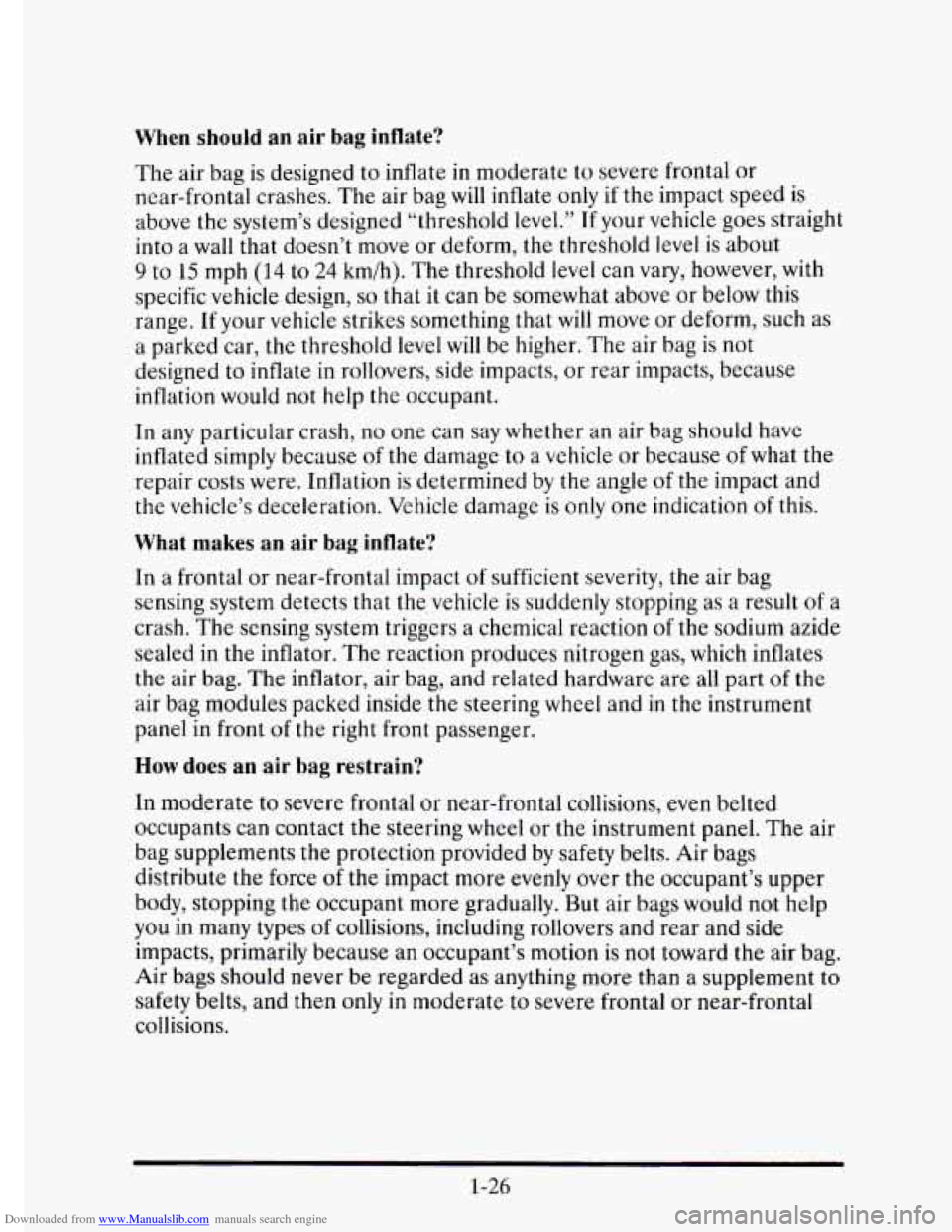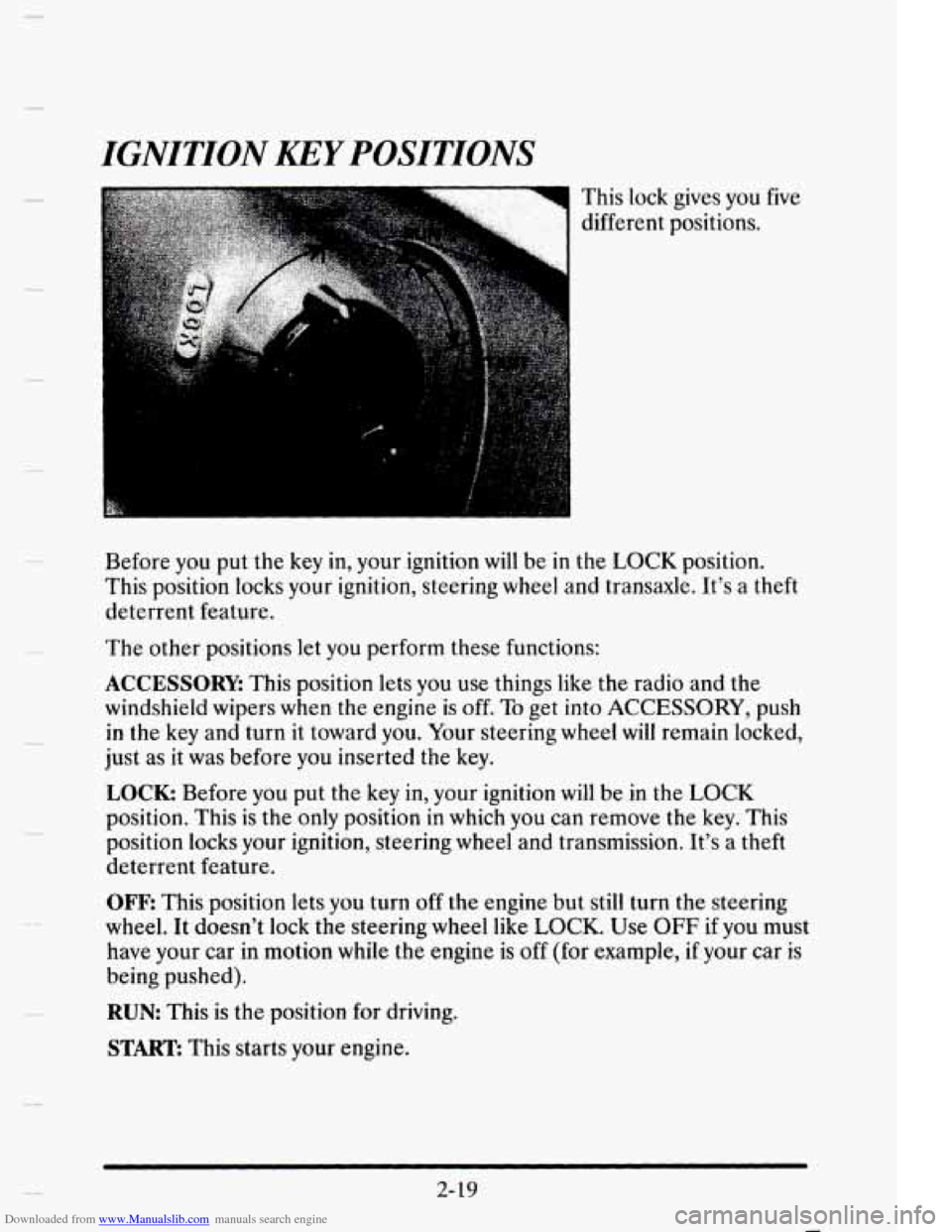1995 CADILLAC ELDORADO wheel
[x] Cancel search: wheelPage 8 of 395

Downloaded from www.Manualslib.com manuals search engine For the 1948 model. Cadillac
introduced the
which set
the trend in automotive
styling for nearly
two decades. This
was followed by the 1949 model with
the
rwo door hardiop Coupe DeVilIe
and the modern overhead valve,
high co-pression
V8 engine.
Engineering
innervations, con-
veniences and styling dotninated
the
'50s and '60s. Cruise controli auto-
matic climate control,
tiit and
telescoping steering wheels, twilight
sentinel and four door hard tops
all
debuted in these years. In 1957 the
Eldorado Brougham featured
ad-
vances such as air suspension, mem-
ory
seat, automatic electric d.oor
locks, transistor radio, a brushed stainless steel
roof and
low profile
tires.
introduced in
1953, was redesigned for t967 as the
first front wheel drive personal
lux-
ury car. The 472 cu. in. V8 engine
used-
in all Cadillacs in 1968 and
1969 was enlarged to 500 cu. in. for
all 1970 Eldorados.
An
Air Cushion Restraint Sys-
tem (airbag) was available for 1974,
1975 and
1976 Cadillacs.
Analog Electronic Fu.el Injec-
tion was available, on
1975 Cadillacs
and was standard on the new inter-
national size 1976 Sevifle. In
1978,
the Trip Computer option incor-
. porated an on-board microprocessor.
Page 45 of 395

Downloaded from www.Manualslib.com manuals search engine When should an air bag inflate?
The air bag is designed to inflate in moderate to severe frontal or
near-frontal crashes. The air bag
will inflate only if the impact speed is
above the system’s designed “threshold level.” If your vehicle goes straight
into a wall that doesn’t move or deform, the threshold level is about
9 to 15 mph (14 to 24 km/h). The threshold level can vary, however, with
specific vehicle design,
so that it can be somewhat above or below this
range. If your vehicle strikes something that
will move or deform, such as
a parked car, the threshold level
will be higher. The air bag is not
designed to inflate
in rollovers, side impacts, or rear impacts, because
inflation would not help thc occupant.
In any particular crash,
no one can say whether an air bag should have
inflated simply because
of the damage to a vehicle or because of what the
repair costs were. Inflation is determined by the angle of the impact and
the vehicle’s deceleration. Vehicle damage
is only one indication of this.
What makes an air bag inflate?
In a frontal or near-frontal impact of sufficient severity, the air bag
sensing system detects that the vehicle
is suddenly stopping as a result of a
crash. The sensing system triggers a chemical reaction of the sodium azide
sealed in the inflator. The reaction produces nitrogen gas, which inflates
the air bag. The inflator, air bag, and related hardware are all part
of the
air bag modules packed inside the steering wheel and in the instrument
panel in front of the right front passenger.
How does an air bag restrain?
In moderate to severe frontal or near-frontal collisions, even belted
occupants can contact the steering wheel or the instrument panel. The air
bag supplements the protection provided by safety belts. Air bags
distribute the force
of the impact more evenly over the occupant’s upper
body, stopping the occupant more gradually. But air bags would not help
you in many types of collisions, including rollovers and rear and side
impacts, primarily because an occupant’s motion
is not toward the air bag.
Air bags should never be regarded as anything more than a supplement to
safety belts, and then only in moderate to severe frontal or near-frontal
collisions.
Page 46 of 395

Downloaded from www.Manualslib.com manuals search engine What will you see after an air bag inflates?
After the air bag inflates, it quickly deflates. This occurs so quickly that
some people may
not even realize the air bag inflated. Some components
of the air bag module in the steering wheel hub for the driver’s air bag, or
the instrument panel for the right front passenger’s bag, wiIl be hot for a
short time, but the part
of the bag that comes into contact with you will
not be hot to the touch. There will be some smoke and dust coming from
vents
in the deflated air bags. Air bag inflation will not prevent the driver
from seeing or from being able
to steer the vehicle, nor will it stop people
from leaving the vehicle.
LI
In many crashes severe enough to inflate an air bag, windshields are
broken by vehicle deformation. Additional windshield breakage may also
occur from the right front passenger air
bag.
0
0
0
The air bags are designed to inflate only once. After they inflate, you’ll
need some new parts for your air bag system. If you don’t get them, the
air bag system won’t
be there to help protect you in another crash. A
new system will include air bag modules and possibly other parts. The
service manual for your vehicle covers the need
to replace other parts.
Your vehicle
is equipped with a diagnostic module, which records
information about the
air bag system. The module records information
about the readiness
of the system, when the sensors are activated and
driver’s safety belt usage at deployment.
Let only qualified technicians work on your air bag system. Improper
service can mean that your air bag
system won’t work properly. See
your dealer for service.
1-27
Page 47 of 395

Downloaded from www.Manualslib.com manuals search engine NOTICE:
If you damage the cover for the driver’s or the right front
passenger’s air bag, they may not work properly. You
may have
to replace the air bag module
in the steering wheel or both the
air bag module and the instrument panel
for the right front
passenger’s air bag.
Do not open or break the air bag covers.
Servicing Your Air Bag-Equipped Cadillac
Air bags affect how your Cadillac should be serviced. There are parts of
the air bag system in several places around your vehicle. You don’t want
the system to inflate while someone is working on your vehicle. Your
Cadillac dealer and the 1995 Eldorado Service Manual have information
about servicing
your vehicle and the air bag system. To purchase a service
manual, see “Service Publications” in the Index.
The air
bag system does not need regular maintenance.
A CAUTION:
For up to 10 seconds after the ignition key is turned off and the
battery
is disconnected, an air bag can stili inflate during
improper service. You can be injured if you are close to an air
bag when it inflates. Avoid wires wrapped with yellow tape, or
yellow connectors. They are probably part of the air bag system.
Be sure to follow proper service procedures, and make sure the
person performing work for you
is qualified to do so.
i
1-28
Page 85 of 395

Downloaded from www.Manualslib.com manuals search engine GLOW BOX
The glove box is
directly in front
of the
front passenger seat.
To lock the glove box
door, insert the oval
key into the lock
cylinder
and turn it
clockwise a quarter
turn and remove the
key. To unlock the
door, turn the key
counterclockwise and
remove
the key.
The
key may be removed in the locked or unlocked position.
THEFT
Vehicle theft is big business, especially in some cities. Although your
Cadillac has a number of theft detcrrent features, we
know that nothing
we put on
it can make it impossible to steal. However, there are ways you
can help.
Key in the Ignition
If you walk away from your vehicle with the keys inside, it's an easy target
for
joy riders or professional thieves -- so don't do it.
When you park your Cadillac and open
the driver's door, you'll hear a
chime reminding you
to remove your key from the ignition and take it
with you. Always do this. Your steering wheel will be locked, and so will
your ignition and transaxle. And remember to lock the doors.
Parking at Night
Park in a lighted spot, close all windows and lock your vehicle. Remember
to keep your valuables out
of sight. Put them in a storage area, or take
them with
you.
2-14
Page 90 of 395

Downloaded from www.Manualslib.com manuals search engine IGNITION KEY POSITIONS
This lock gives you five
different positions.
Before you
put the key in, your ignition will be in the LOCK position.
This position locks your ignition, steering wheel and transaxle. It’s a theft
deterrent feature.
The other positions let you perform these functions:
ACCESSORY: This position lets you use things like the radio and the
windshield wipers when
the engine is off. To get into ACCESSORY, push
in the key and turn it toward you. Your steering wheel will remain locked,
just
as it was before you inserted the key.
LOCK: Before you put the key in, your ignition will be in the LOCK
position. This is the only position in which you can remove the key. This
position locks your ignition, steering wheel and transmission. It’s a theft
deterrent feature.
OFF
This position lets you turn off the engine but still turn the steering
wheel. It doesn’t lock the steering wheel like LOCK. Use OFF if you must
have your car in motion while the engine
is off (for example, if your car is
being pushed).
RUN: This is the position for driving.
START: This starts your engine.
2-19
Page 91 of 395

Downloaded from www.Manualslib.com manuals search engine I NOTICE:
If your key seems stuck in LOCK and you can’t turn it, be sure
it is all the way in. If it is, then turn the steering wheel left and
right while
you turn the key hard. But turn the key only with
your hand. Using a tool to force it could break the key
or the
ignition switch.
If none of this works, then your vehicle needs
service.
STARTING YOUR ENGINE
Move your shift lever to PARK (P) or NEUTRAL (N). Your engine won’t
start
in any other position -- that’s a safety feature. To restart when you’re
already moving, use
NEUTRAL (N) only.
~ ~~ ~
NOTICE:
Don’t try to shift to PARK (P) if your Cadillac is moving. If you
do, you could damage the transaxle. Shift to
PARK (P) only
when your vehicle is stopped.
To start your Northstar V8 engine:
1. Without pushing the accelerator pedal, turn your ignition key to
START When the engine starts, let go of the key. The idle speed will
go down as your engine gets warm.
NOTICE:
Holding your key in START for longer than 15 seconds at a time
will cause your battery to be drained much sooner.
And the
excessive heat can damage your starter motor.
2-21)
Page 94 of 395

Downloaded from www.Manualslib.com manuals search engine AUTOMATIC TMSXKLE
Your automatic transaxle may have either a shift lever located on the
steering column or
on the console between the seats.
BRN@3211
'I
i
There are several different positions for your shift lever.
PARK (P): This locks your front wheels. It's the best position to use when
you start your engine because your vehicle can't move easily.
2-23